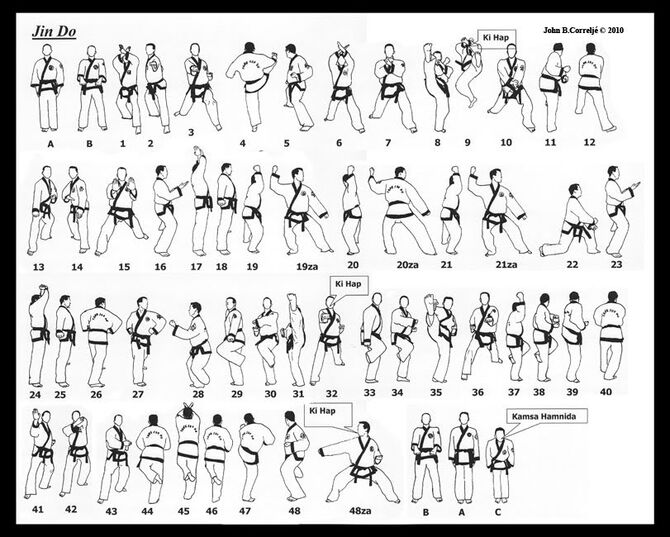This form is a traditional taekwondo form, meaning it pre-dates contemporary forms (such as those used by the ITF, ATA, and WT). In other words, this is a form used during the 1950s within the Nine Kwans that eventually came together to form taekwondo.
- Older forms such as this one were often based on forms from other martial arts.
- The details and names of these older forms tend to vary more widely from school to school as well.
The version shown here is just one version; the reader should recognize that there will be variations among schools.
Jin Do (Chintō in Shotokan, Gankaku (岩鶴)) is an advanced kata practiced in many styles of Karate. According to legend, it is named after a Chinese sailor, sometimes referred to as Annan, whose ship crashed on the Okinawan coast. To survive, Chintō stole from the crops of the local people. Matsumura Sōkon, a Karate master and chief bodyguard to the Ryūkyūan king, was sent to defeat Chintō. In the ensuing fight, however, Matsumura found himself equally matched by the stranger, and consequently sought to learn his techniques.
It is known that the kata Chintō was well-known to the early Tomari-te and Shuri-te schools of Karate. Matsumura Sōkon was an early practitioner of the Shuri-te style. When Gichin Funakoshi brought Karate to Japan, he renamed Chintō (meaning approximately "fighter to the east") to Gankaku (meaning "crane on a rock"), possibly to avoid anti-Chinese sentiment of the time. He also modified the actual pattern of movement, or embusen, to a more linear layout, similar to the other Shotokan kata.
The kata is very dynamic, employing a diverse number of stances (including the uncommon crane stance), unusual strikes of rapidly varying height, and a rare one-footed pivot.
It is often said that Chintō should be performed while facing eastwards.
Video
Diagram
This diagram is copyright John B. Correljé and is used with permission. Terms and conditions are available at http://sites.google.com/site/tangsoodochonkyong 
Written Instructions
No written instructions have yet been added for this technique. You can contribute to Taekwondo Wiki by adding written instructions.
See: http://www.peterliciaga.com/jin-do-hyung-history-and-meaning/
